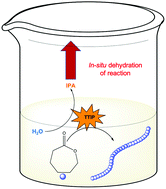Ring opening polymerization of ε-caprolactone through water†
Abstract
Ring opening polymerization (ROP) is commonly used to synthesize biodegradable polymers such as polycaprolactone (PCL). These reactions typically demand anhydrous reagents and inert atmosphere, only attainable through the use of complex setups including glove boxes and Schlenk lines. Because of these practical limitations, ROP is typically inaccessible to the non-expert. Herein, we have developed two techniques for limited ROP of ε-caprolactone (CL) without previous drying of reagents by simply conducting the reaction in a laboratory oven. In the first method, a vacuum oven was used to evaporate water from a traditional ROP reaction with stannous octoate (Sn(Oct)2) as the catalyst. In the second method, we ‘polymerize through’ water using titanium isopropoxide (TTIP) to simultaneously quench residual water and catalyze ROP. Using these two methods, we achieved variable chain length (degree of polymerization (DP) 25–500) and molecular weight distribution (Đ = 1.3–1.5) of PCL. We found that ROP with TTIP works better for higher molecular weights up to DP 500 than Sn(Oct)2 under vacuum. Moreover, we investigated the living nature of ROP with TTIP where a block copolymer of PCL-PLA was achieved.



 Please wait while we load your content...
Please wait while we load your content...